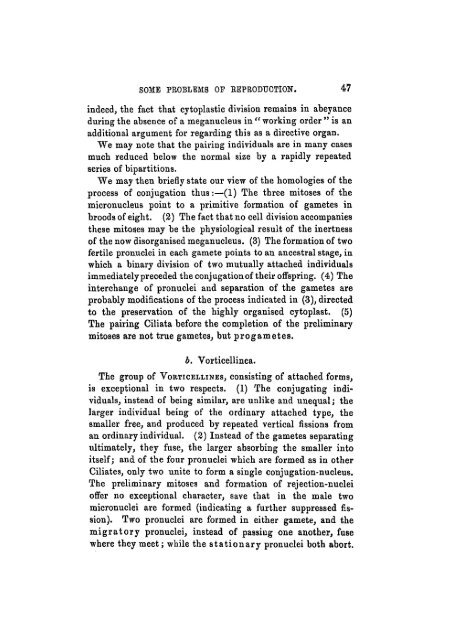Some Problems of Reproduction: a Comparative Study of ...
Some Problems of Reproduction: a Comparative Study of ...
Some Problems of Reproduction: a Comparative Study of ...
Create successful ePaper yourself
Turn your PDF publications into a flip-book with our unique Google optimized e-Paper software.
SOME PROBLEMS OF REPRODUCTION. 47<br />
indeed, the fact that cytoplastic division remains in abeyance<br />
during the absence <strong>of</strong> a meganucleus in " working order " is an<br />
additional argument for regarding this as a directive organ.<br />
We may note that the pairing individuals are in many cases<br />
much reduced below the normal size by a rapidly repeated<br />
series <strong>of</strong> bipartitions.<br />
We may then briefly state our view <strong>of</strong> the homologies <strong>of</strong> the<br />
process <strong>of</strong> conjugation thus:—(1) The three mitoses <strong>of</strong> the<br />
micronucleus point to a primitive formation <strong>of</strong> gametes in<br />
broods <strong>of</strong> eight. (2) The fact that no cell division accompanies<br />
these mitoses may be the physiological result <strong>of</strong> the inertness<br />
<strong>of</strong> the now disorganised meganucleus. (3) The formation <strong>of</strong> two<br />
fertile pronuclei in each gamete points to an ancestral stage, in<br />
which a binary division <strong>of</strong> two mutually attached individuals<br />
immediately preceded the conjugation <strong>of</strong> their <strong>of</strong>fspring. (4) The<br />
interchange <strong>of</strong> pronuclei and separation <strong>of</strong> the gametes are<br />
probably modifications <strong>of</strong> the process indicated in (3), directed<br />
to the preservation <strong>of</strong> the highly organised cytoplast. (5)<br />
The pairing Ciliata before the completion <strong>of</strong> the preliminary<br />
mitoses are not true gametes, but progametes.<br />
b. Vorticellinea.<br />
The group <strong>of</strong> VORTICELLINES, consisting <strong>of</strong> attached forms,<br />
is exceptional in two respects. (1) The conjugating individuals,<br />
instead <strong>of</strong> being similar, are unlike and unequal; the<br />
larger individual being <strong>of</strong> the ordinary attached type, the<br />
smaller free, and produced by repeated vertical fissions from<br />
an ordinary individual. (2) Instead <strong>of</strong> the gametes separating<br />
ultimately, they fuse, the larger absorbing the smaller into<br />
itself; and <strong>of</strong> the four pronuclei which are formed as in other<br />
Ciliates, only two unite to form a single conjugation-nucleus.<br />
The preliminary mitoses and formation <strong>of</strong> rejection-nuclei<br />
<strong>of</strong>fer no exceptional character, save that in the male two<br />
micronuclei are formed (indicating a further suppressed fission).<br />
Two pronuclei are formed in either gamete, and the<br />
migratory pronuclei, instead <strong>of</strong> passing one another, fuse<br />
where they meet; while the stationary pronuclei both abort.

















